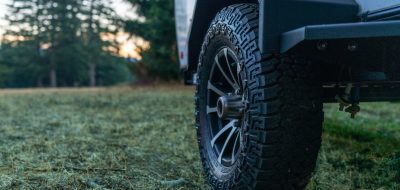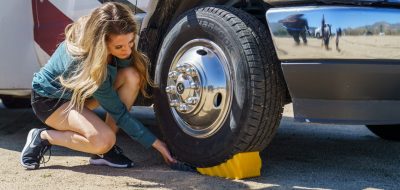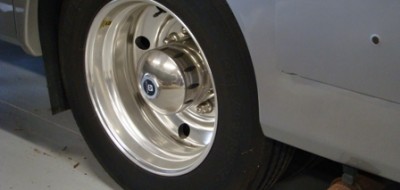You would think that as many miles as we travel to RV shows and rallies each season, we would be prepared for every eventuality involving tires. But on our road trip from Grants Pass, Oregon to Gillette, Wyoming for the Escapees Escapade, we experienced a “perfect storm” of tire troubles.
Before every trip, we check the weight of our rigs and set the tire pressure accordingly. One of our vehicles is a Chevy G30 1.5 ton van, and this time, we noticed that one of the inside duals was flat. Upon checking the date code, we realized they were more than seven years old already! Okay…time to replace all four rears, then…the front tires were still in good shape.
Unfortunately, no one in Grants Pass or Medford had the tires we wanted, so we had to settle for some tires that could at least carry the weight and had a full steel casing. A full steel casing is important, because it utilizes steel in the tread as well as the sidewall, as opposed to some truck tires that have polyester sidewalls.
Okay, we’re on the road again, but we immediately notice a problem…the rear of the truck was rut tracking (following ruts) all over the road-it was very difficult just to keep it in the lane. After two hours, we couldn’t take it anymore and stopped again in Eugene, Oregon and had the rear tires replaced with Michelins. The Les Schwab dealer there was kind enough to swap out the tires, and all we did was pay the difference in price.
We noticed that the biggest difference was the contact patch of the tires we replaced vs. the Michelins. When you held the two up next to each other, the Michelin was about an inch wider. We had also gone from a 8R19.5 (which is being phased out) to a 225/70, which has a shorter sidewall. That makes a big difference, too, because less sidewall flex results in greater stability. And, since there is more rubber on the road, the Michelins can actually handle more weight. What a difference! Now I could drive the rig with one hand.
But our problems weren’t over yet-our other rig had been experiencing some problems as well. This one is a ’98 Chevy Express 3500 van towing a 12-foot enclosed trailer. It had a vibration that surfaced at highway speeds. We stopped at another shop, and they told us that the problem was belt separation, which I had a hard time believing. Full steel casing tires don’t ordinarily have these problems, but we purchased one right rear tire just the same. We sure didn’t want to take any chances.
Back on the road, there was hardly any change to the vibration, if any. The problem was, I wasn’t watching the guys at this shop do everything, because I was at the other shop tending to the G30 van. I wanted them to check to see if we had a brake drum out of balance, but for some reason, they said they couldn’t do it. So before we left Spokane, Washington, I decided to check for myself and see what was going on. We jacked up the rear of the van, supported it with jack stands, and blocked the front wheels. Then we started it up, and let it idle in low gear. First, I watched the driveline as it spun around, then got behind the rear wheels and watched them turn. From here, you can see if the tire moves from side to side or up and down as it spins.
I discovered we had lateral runout as well as a little radial runout on the wheel/tire assembly. Obviously, you can’t get a smooth ride unless the tire and wheel assembly is round-it doesn’t matter if it’s in balance or not. Clearly, there was nothing we could do about this while on the road, but at least we now knew what the problem was. We’re going to check it out in more detail when we get back to the shop.
The point of all this? We have troubles on the road just like everyone else, and I wanted to share our experiences with fellow RVers. That’s one of the advantages of traveling around the country-I’ve been on road trips and had transmissions blow up as well as all kinds of other troubles. Experiences like these serve to remind us that, even though we’re in the RV repair business, problems can still happen to us. That’s why we have empathy for our customers and never forget what can happen on the road.





Pingback: flyttstädning stockholm
Robert A. Henderson
Hello Folks,
Great idea to check those date codes on the tires before hitting the road. That is a very special tire you have on your 5th wheel. That G159 Goodyear has been one of my favorite tires for RV’s. Full steel casing and a closed shoulder ribbed tire. Works well on a trailer with all the scrubbing that goes on back there while parking or doing tight turns. However the G159 has been discontinued. The new tire from Goodyear that they recommend for trailers carrying heavy loads is the G614 RST . They will carry 3750 at 110 PSI.
Any qualified tire store should be able to mont these. If you can’t find any let us know we are a Goodyear dealer. Michelin , to the best of my knowledge does not make a tire that size in a G rating.
Have a great day and best wishes for happy travels. Robert
Pam Rank
Hi Robert
We found your blogs on tires and were wondering if you had ever addressed replacing tires for the RV. We have to replace ours before hitting the road in late September. We bought our 5th wheel second hand and found that the tires are still orginal (from 1998). From what we’ve been able to learn online, it appears that these tires were actually recalled at some point – Goodyear G159 LT235/85R16 Unisteel Log range G. Now we’re concerned that we may go thru the same problem you encountered by getting the wrong tires.
Here are our questions. How would you suggest finding the correct tires, and will a regular tire dealer be able to install them properly or do we need to go to a specialty shop. The RV dealers in our area don’t install tires.
Thanks for your help